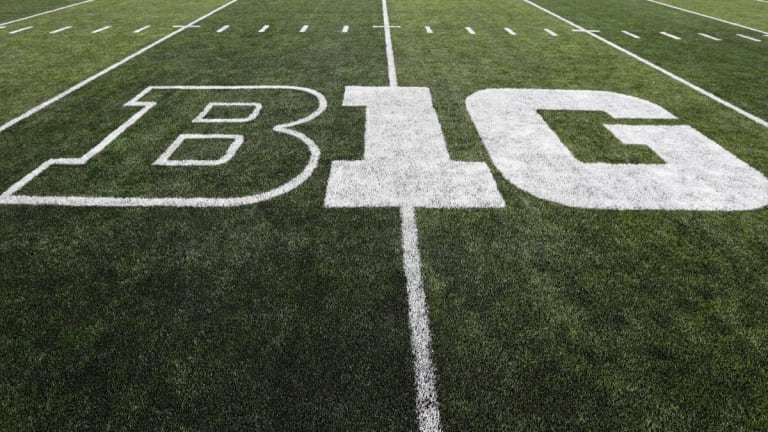
Big Ten To Play A "Championship Weekend" 9th Game Of 2020 Season

CHAMPAIGN, Ill. -- The Big Ten Conference has created its version of a championship weekend for its final weekend of its 2020 fall season.
Wisconsin athletics director Barry Alvarez, who was the chairperson of the Big Ten’s return to competition task force, confirmed on Big Ten Network Wednesday morning that the league schedule will be a eight-game regular season and then a "championship week" that will include the Big Ten Championship Game in Indianapolis on Dec. 19 but also every team in the league will play a crossover game based on where they finish in their divisional standings. According to a follow-up question to Alvarez, the league is aiming to avoid repeat games for the Week 9 matchups of the season that aren't the championship games so it may not be a straight matching up by corresponding seeds but East No. 2 vs. West No. 2 and so will be a preferred method of determining that ninth game.
“The return of Big Ten football is great news for our team and all our Fighting Illini football fans,” Illinois head coach Lovie Smith said in a university statement. “We feel that the University of Illinois has the strongest testing system and protocol of anyone in the nation and that we can compete while keeping our players safe. Our team has put in some incredible work over the last several months and after meeting with them earlier today, I know they are extremely excited to start preparing for the 2020 season.”
The Big Ten Championship Game in Indianapolis is slated to be played one day before the College Football Playoff selection committee is scheduled to release its four-team bracket on ESPN.
“Today’s announcement brings many emotions,” Illinois athletics director Josh Whitman said in a university statement. “I am grateful to my colleagues across the Big Ten Conference, including Commissioner Warren, the Big Ten staff, the other 13 athletic directors, our coaches, and our medical professionals, all of whom have worked tirelessly for many months to play Big Ten sports as safely as possible in the midst of our world’s current health challenges. These efforts have only intensified in these last weeks, and I have been more impressed than ever with the collaboration, resourcefulness, and determination needed to arrive at today’s decision. I want to thank the presidents and chancellors of our 14 member institutions for their unyielding concern for our staff, student-athletes, and fans; for their trust and confidence in the work and guidance of our various practitioners, especially our medical experts; and for their strength and leadership in making hard decisions in difficult circumstances. More than anything, I want to thank our student-athletes. From day one, they have done everything we have asked of them. Their competitiveness, work ethic, flexibility, patience, inquisitiveness, sacrifice, and commitment have been an inspiration for me and for all. I have never been so proud to be associated with the University of Illinois and the Big Ten Conference, and I am excited to continue the tough, gritty progress needed to see our teams compete at the highest level this year in the safest, healthiest environment we can create.”
According to the league media release, the league will use data provided by each Chief Infection Officer (CInO) to make decisions about the continuation of practice and competition, as determined by team positivity rate and population positivity rate, based on a seven-day rolling average:
Team positivity rate (number of positive tests divided by total number of tests administered):
Green: 0-2%
Orange: 2-5%
Red: >5%
Population positivity rate (number of positive individuals divided by total population at risk):
Green: 0-3.5%
Orange: 3.5-7.5%
Red: >7.5%
Decisions to alter or halt practice and competition will be based on the following scenarios:
Green/Green and Green/Orange: Team continues with normal practice and competition.
Orange/Orange and Orange/Red: Team must proceed with caution and enhance COVID-19 prevention (alter practice and meeting schedule, consider viability of continuing with scheduled competition).
Red/Red: Team must stop regular practice and competition for a minimum of seven days and reassess metrics until improved.
All COVID-19 positive student-athletes will have to undergo comprehensive cardiac testing to include labs and biomarkers, ECG, Echocardiogram and a Cardiac MRI. Following cardiac evaluation, student-athletes must receive clearance from a cardiologist designated by the university for the primary purpose of cardiac clearance for COVID-19 positive student-athletes. The earliest a student-athlete can return to game competition is 21 days following a COVID-19 positive diagnosis. The daily testing will begin by September 30.
“Everyone associated with the Big Ten should be very proud of the groundbreaking steps that are now being taken to better protect the health and safety of the student-athletes and surrounding communities,” Dr. Jim Borchers, Head Team Physician, The Ohio State University and co-chair of the Return to Competition Task Force medical subcommittee said in the league media release. "The data we are going to collect from testing and the cardiac registry will provide major contributions for all 14 Big Ten institutions as they study COVID-19 and attempt to mitigate the spread of the disease among wider communities.”
